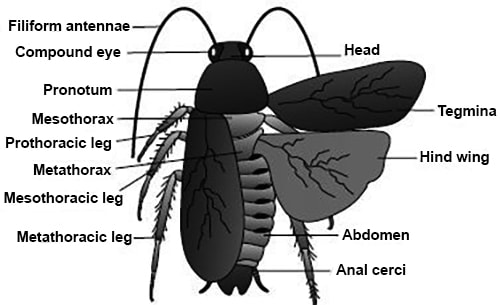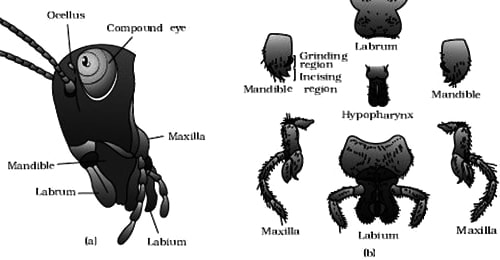The adults of the common species of cockroach, Periplaneta americana are about 34-53 mm long with wings that extend beyond the tip of the abdomen in males. As an arthropod, the body of a cockroach is separable into three different regions. The body of the cockroach is segmented and divisible into three distinct regions – head, thorax and abdomen (Figure).

A cockroach is a dioecious animal, with detach male and female sexes. The entire body is covered by a hard chitinous exoskeleton (brown in color). In each segment, the exoskeleton has hardened plates called sclerites (tergites dorsally and sternites ventrally) that are joined to each other by a thin and flexible articular membrane (arthrodial membrane). The male species are longer in length while the females are somewhat lesser than the males.
The head is triangular in shape and lies anteriorly at right angles to the longitudinal body axis. It is formed by the fusion of six segments and shows great mobility in all directions due to a flexible neck (Fig-a). The head capsule bears a pair of compound eyes. It is a distinct triangular shape. A pair of compound eyes are present on the head. A pair of thread-like antennae arise from membranous sockets lying in front of the eyes. Antennae have sensory receptors that help in monitoring the environment. The anterior end of the head bears appendages forming biting and chewing type of mouthparts. The mouthparts consisting of a labrum (upper lip), a pair of mandibles, a pair of maxillae and a labium (lower lip).

A median flexible lobe, acting as the tongue (hypopharynx), lies within the cavity enclosed by the mouthparts (Figure -b). Thorax consists of three parts – prothorax, mesothorax, and metathorax. The head is connected with thorax by a short extension of the prothorax known as the neck. Each thoracic segment bears a pair of walking legs.
The first pair of wings arise from mesothorax and the second pair from metathorax. Forewings (mesothoracic) called tegmina are opaque dark and leathery and cover the hind wings when at rest. The hind wings are transparent, membranous and are used in flight.
In Summary –
Head: It bears a pair of compound eyes and two long antennae arising from their head. The head is formed by the fusion of six segments. A median elastic lobe acts as the tongue. The flexible neck facilitates movement in all directions. Antennae have sensory receptors.
Mouth Parts: The mouthparts consist of a labrum (upper lip), a pair of mandibles, a pair of maxillae and a labium (lower lip). This lobe acts as a tongue (hypopharynx).
Thorax: The thorax is divided into three parts- Prothorax, Mesothorax, and Metathorax. The head is joined with the thorax by a little porch of prothorax; called neck. The thorax region also bears a pair of legs. The first pair of wings arise from mesothorax and the second pair arises from metathorax. It also consists of forewings called tegmina. The hind wings are apparent, membranous and are used in flight.
Abdomen: The abdomen consists of 10 segments. The 7th sternum, along with the 8th and 9th sterna bears a broad genital pouch. In females, the 7th segment is boat-shaped. In males, the genital pouch lies at the hind end of the abdomen. In both sexes, the 10th segment contains a pair of the joint filamentous formation called anal cerci.












